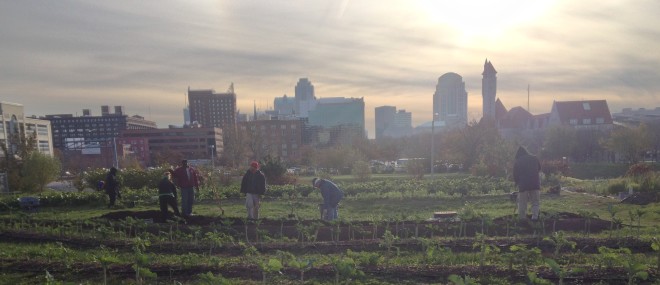Urban Agriculture: Back to Basics
BY HENRY OSMAN
For the last few years, urban agriculture has been touted as an “innovative solution,” one that will radically change the fabric of our cities by ending food deserts and filling in abandoned neighborhoods. But urban farming is not a new movement; our grandparents had victory gardens to supplement wartime rations and historic parks like the Boston Common were used to graze sheep. Urban agriculture is, and has always been, an integral part of the urban fabric. The question should not be about finding an innovative or novel solution, but rather about finding one that works, one that is sustainable, and one that helps communities stay together and fight malnutrition.
But what defines an urban farm? It is not easy to find a definition because urban farms take so many different shapes. The only uniting factor is that they grow plants and may raise livestock in a city. Besides that, they can be small community gardens, larger 16 bed farms, or even a farm that lets refugees grow traditional foods to preserve their culture. Trying to define them misses the elusive benefits that the farms create; they keep communities together, decrease crime and fill in the vacant land that so many cities suffer from after decades of government neglect and racial division.
Some of the most important benefits of urban agriculture are that the movement, unlike the local or organic food movements, is economically and racially diverse. Knowledge about food production and nutrition, just like healthy, fresh, and cheap food itself, is not equally distributed, and food justice is an integral part of urban farming. This comes out of its grassroots history and foundation in social justice; farms are tied to their communities and actively give back to them by providing low-cost or free food, exercise through farming, and green and communal spaces.
Too often these farms get overshadowed by state-of-the-art rooftop farms that can grow tens of thousands of dollars of produce, housing developments that integrate vertical farms, or permacultures that integrate fish farming and chicken coops. High-tech developments produce food more efficiently and use less land, but, as they are not engaged in the surrounding communities, they miss out on the communal benefits of smaller farms.
Rooftop farms may be necessary in the future if there is a food crisis, and should be praised for their sustainability and ingenuity, but it is important to keep in mind that they are for-profit ventures that sell their produce to the highest bidders, generally restaurants. While governments should fund small farms that interact with their communities and produce positive externalities, the expansion of roof top farms should be left to the free market. It is not that urban farming cannot be profitable, but profits should not be the metric by which a farm measures its success. If a farm devotes itself to maximizing profits with no regard for the community, it deserves little support.
Because many small farms are not usually profit motivated, they rely on a supportive community to get going. The process is extremely laborious, and it is difficult to do with just one or two people because the land is simply not welcoming. Years of lead paint and industrial development have poisoned the ground, and produce grown from that soil can be contaminated. St. Louis, with its history of large factories, has extremely polluted soil, and farms need to cap it off with clay, cover it in tarps, and truck in soil. The City of St Louis gives free mulch and water to farms, but even getting to that step is tough. Moreover, funding can be difficult to obtain. There are many great organizations, but it is still difficult for communities to not only learn about what funding is offered, but also how to write grants and take advantage of the available resources.
Urban farming won’t cure all of our city’s ills, but it is one of the best solutions we have. Our municipal governments need to rezone for urban agriculture so that farms can be started on any vacant lot, reduce zoning and registration fees, and allow them special exemptions to have chickens. The many benefits these farms provide, like fresh produce, education about the food system, and the social network created by farming, have lifelong effects. Everyone should have access to fresh food, know where their food comes from, who grows it, and the ethics behind it.
